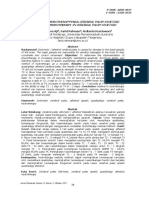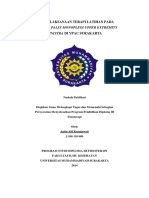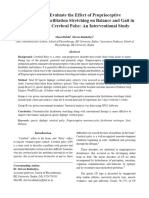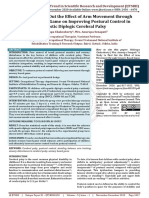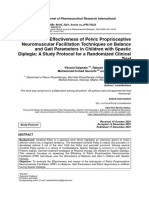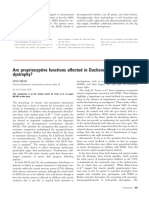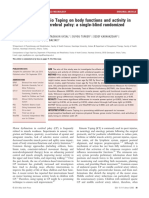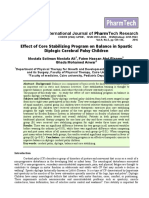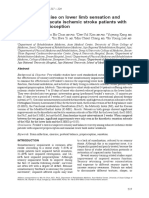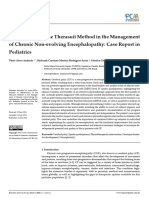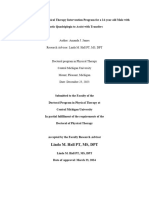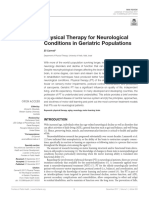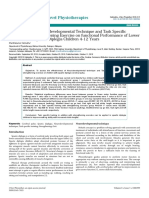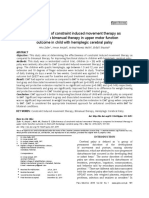Effectiveness of Task Oriented Circuit Training On Functional Mobility and Balance in Cerebral Palsy
Effectiveness of Task Oriented Circuit Training On Functional Mobility and Balance in Cerebral Palsy
Uploaded by
diliana sotoCopyright:
Available Formats
Effectiveness of Task Oriented Circuit Training On Functional Mobility and Balance in Cerebral Palsy
Effectiveness of Task Oriented Circuit Training On Functional Mobility and Balance in Cerebral Palsy
Uploaded by
diliana sotoOriginal Title
Copyright
Available Formats
Share this document
Did you find this document useful?
Is this content inappropriate?
Copyright:
Available Formats
Effectiveness of Task Oriented Circuit Training On Functional Mobility and Balance in Cerebral Palsy
Effectiveness of Task Oriented Circuit Training On Functional Mobility and Balance in Cerebral Palsy
Uploaded by
diliana sotoCopyright:
Available Formats
DOI Number: 10.5958/j.0973-5674.7.4.
116
Indian Journal of Physiotherapy & Occupational Therapy. October-December 2013, Vol. 7, No. 4 23
Effectiveness of Task Oriented Circuit Training on
Functional Mobility and Balance in Cerebral Palsy
Chandan Kumar1, Shina Kataria2
1 2
Assistant Professor, M.P.T (Neurology- Student), M. M. Institute Of Physiotherapy And Rehabilitation,
Mullana, Ambala
ABSTRACT
Purpose: The goal of this study is to determine the efficacy of task related circuit training on functional
mobility and balance in children with spastic diplegic type of cerebral palsy.
Methodology: This was an experimental study of 30 children with spastic diplegic cerebral palsy
having a GMFM level of I or II. All the subjects were enrolled in an identical subgroup and divided
into two equal groups (15 patient in each group) one experimental and another control group.
Experimental group did task oriented circuit training while control group performed conventional
exercise program.
We assessed the Functional mobility of lower extremity and balance of all patients by Timed Up and
Go test and Pediatric balance scale respectively.
Results: Result shows that both the groups improved significantly but task oriented circuit training
group improved more than the conventional training group.
Conclusions: This study suggests that task oriented circuit training is more effective as compared to
the conventional training for the functional mobility and balance in spastic diplegic cerebral palsy
children.
Keywords: Task Oriented Training, Circuit Training, Cerebral Palsy Rehabilitation, Mobility, Balance
INTRODUCTION The Common Impairments Due To Cerebral palsy are
Cerebral palsy (CP) is a neurodevelopmental About 70 to 80 percent of cerebral palsy children
condition beginning in early childhood and persisting have spastic clinical features like increased deep
throughout the lifespan1. Worldwide prevalence of this tendon reflexes, tremors, muscular hyper tonicity,
disorder is 2 to 2.5 per 1000 live births. Cerebral palsy weakness and a characteristic scissoring gait with toe
results in lifelong disability in children and has walking4.
implication for patients, caregivers, health professional
and general society. Therefore the goals of treatment Motor impairment syndrome seen in cerebral palsy
are to improve functionality and capabilities toward is secondary to lesion or anomalies in brain
independence2. development that inhibit normal automatic and
voluntary responses and allowing for the development
Peter Rosenbaum, Nigel Paneth described cerebral of dysfunction. The CP children have gait pathologies
palsy as a group of permanent disorders of the and tend to loose independent walking at later stages
movement and posture, causing activity limitation that of life because of secondary musculoskeletal
are attributed to non-progressive disturbances that abnormalities increased spasticity, balance problems,
occurred in the developing fetal or infant brain. The and lack of physical training5.
motor disorders of cerebral palsy are often
accompanied by disturbances of sensation, perception, Most common gait pathology is stiff knee in swing
cognition, communication and behaviour, by epilepsy (80%), followed by crouch gait (69%), excessive hip
and secondary musculoskeletal problems3. flexion (65%), in toeing (64%), and equinus (61%)6.
5. Chandan kumar--23-28.pmd 23 11/26/2013, 4:48 PM
You might also like
- The Hopper 4X8 PlansDocument22 pagesThe Hopper 4X8 Plansjordannwsp100% (2)
- Original Article: Effects of Neurodevelopmental Therapy On Gross Motor Function in Children With Cerebral PalsyDocument6 pagesOriginal Article: Effects of Neurodevelopmental Therapy On Gross Motor Function in Children With Cerebral PalsyIkhwatul FitriNo ratings yet
- 4513 10918 1 PB PDFDocument13 pages4513 10918 1 PB PDFRama BayuNo ratings yet
- Cerebral Palsy Monoplegi Upper Extremity Sinistra Di Ypac SurakartaDocument17 pagesCerebral Palsy Monoplegi Upper Extremity Sinistra Di Ypac SurakartaVeronika AtaNo ratings yet
- Ijpd 24 345Document7 pagesIjpd 24 345Gek DewiNo ratings yet
- 7Document7 pages7Amr Mohamed GalalNo ratings yet
- AsiaPacClinTranslNervSystDis1269-8564673 234726Document7 pagesAsiaPacClinTranslNervSystDis1269-8564673 234726JouleAlSBNo ratings yet
- Comparison Between The Effect of NeurodevelopmentaDocument9 pagesComparison Between The Effect of NeurodevelopmentaDellNo ratings yet
- Archive of SID: Research ArticleDocument8 pagesArchive of SID: Research ArticleAnushka RaipureNo ratings yet
- Cerebral Palsy: Causes and Treatment Alternatives, Based On The Evidence Provided by Gait Analysis - Rupcich M, Bravo RDocument2 pagesCerebral Palsy: Causes and Treatment Alternatives, Based On The Evidence Provided by Gait Analysis - Rupcich M, Bravo RRicardo BravoNo ratings yet
- A Study To Find Out The Effect of Arm Movement Through Sensory Based Game On Improving Postural Control in Spastic Diplegic Cerebral PalsyDocument6 pagesA Study To Find Out The Effect of Arm Movement Through Sensory Based Game On Improving Postural Control in Spastic Diplegic Cerebral PalsyEditor IJTSRDNo ratings yet
- 5012-Article Text-7118-1-10-20221006Document8 pages5012-Article Text-7118-1-10-20221006Nieko Caesar AgungNo ratings yet
- 51 55Document5 pages51 55SuniNo ratings yet
- DMCN 12476Document2 pagesDMCN 12476Alcançando EstrelasNo ratings yet
- Neuro Developmental Treatment (NDT) For Cerebral Palsy: - A Clinical StudyDocument2 pagesNeuro Developmental Treatment (NDT) For Cerebral Palsy: - A Clinical StudyInternational Journal of Innovative Science and Research TechnologyNo ratings yet
- The Effects of Kinesio Taping On Body Functions and Activity in Unilateral Spastic Cerebral Palsy: A Single-Blind Randomized Controlled TrialDocument8 pagesThe Effects of Kinesio Taping On Body Functions and Activity in Unilateral Spastic Cerebral Palsy: A Single-Blind Randomized Controlled TrialEddy Lanang'e JagadNo ratings yet
- 26 - Jpts 2013 255Document4 pages26 - Jpts 2013 255rishivivek55No ratings yet
- Effectiveness of Sensory Integration Therapy (Vestibular & Proprioception Input) On Gross Motor Functioning in Developmental Delayed and Spastic Diplegic CP ChildrenDocument6 pagesEffectiveness of Sensory Integration Therapy (Vestibular & Proprioception Input) On Gross Motor Functioning in Developmental Delayed and Spastic Diplegic CP ChildrenYanuar Adi SanjayaNo ratings yet
- Effects of Hippotherapy and Therapeutic Horseback Riding On Postural Control or Balance in Children With Cerebral Palsy: A Meta-AnalysisDocument8 pagesEffects of Hippotherapy and Therapeutic Horseback Riding On Postural Control or Balance in Children With Cerebral Palsy: A Meta-AnalysisEduardo EstevamNo ratings yet
- Management and Treatment For Cerebral Palsy in Chi PDFDocument7 pagesManagement and Treatment For Cerebral Palsy in Chi PDFSumon RahatNo ratings yet
- Comparison Between Task Oriented Training and Proprioceptiveneuromuscular Facilitation Exercises On Lower Extremity Function Ince 2165 7025 1000291Document9 pagesComparison Between Task Oriented Training and Proprioceptiveneuromuscular Facilitation Exercises On Lower Extremity Function Ince 2165 7025 1000291Gopi KrishnanNo ratings yet
- Exercise-Enhanced Neuroplasticity Targeting Motor and Cognitive Circuitry in Parkinson's DiseaseDocument11 pagesExercise-Enhanced Neuroplasticity Targeting Motor and Cognitive Circuitry in Parkinson's DiseaseRed DiggerNo ratings yet
- (129 136) V9N5PTDocument8 pages(129 136) V9N5PTAqila NurNo ratings yet
- 5 Effect of Repetitive Transcranial Magnetic Stimulation in Decreasing Muscle Tone of Spastic HemiplegDocument6 pages5 Effect of Repetitive Transcranial Magnetic Stimulation in Decreasing Muscle Tone of Spastic HemiplegMohamed Serag El-deinNo ratings yet
- Comparison of Different Therapy Approaches in Children With Down SyndromeDocument6 pagesComparison of Different Therapy Approaches in Children With Down SyndromeRosy OktaridaNo ratings yet
- Fine Motor Skills in Patients With Parkinsons Disease: Effect of Auditory CueingDocument9 pagesFine Motor Skills in Patients With Parkinsons Disease: Effect of Auditory CueingRetno WulandariNo ratings yet
- Lectura Ejercicios de FrenkelDocument8 pagesLectura Ejercicios de FrenkelAlex AhuactziNo ratings yet
- BJCR 12Document6 pagesBJCR 12jnicolasgonzaNo ratings yet
- Literature ReviewDocument20 pagesLiterature ReviewMira MakramNo ratings yet
- Case Report 1Document38 pagesCase Report 1api-600595608No ratings yet
- PerffettiDocument5 pagesPerffettiDiana katerine Rodríguez Otálora.No ratings yet
- NIH Public Access: Exercise-Enhanced Neuroplasticity Targeting Motor and Cognitive Circuitry in Parkinson's DiseaseDocument19 pagesNIH Public Access: Exercise-Enhanced Neuroplasticity Targeting Motor and Cognitive Circuitry in Parkinson's DiseaseAgus WiyonoNo ratings yet
- Neuro TheoryDocument9 pagesNeuro TheoryArivuNo ratings yet
- Physical Therapy For Neurological Conditions in Ge PDFDocument6 pagesPhysical Therapy For Neurological Conditions in Ge PDFMuskan AhujaNo ratings yet
- 8Document6 pages8Amr Mohamed GalalNo ratings yet
- Delaying Mobility Disability in People With Parkinson Disease Using A Sensorimotor Agility Exercise Program.Document12 pagesDelaying Mobility Disability in People With Parkinson Disease Using A Sensorimotor Agility Exercise Program.Belén Perez DaltoNo ratings yet
- Rajivgandhi University of Health Sciences, Karnataka, Bangalore Annexure Ii Proforma For Registration of Subjects For DissertationDocument11 pagesRajivgandhi University of Health Sciences, Karnataka, Bangalore Annexure Ii Proforma For Registration of Subjects For DissertationDavid SugiartoNo ratings yet
- 18 01 031 20200804Document7 pages18 01 031 20200804christinaceciliaaNo ratings yet
- Jgs 12506Document8 pagesJgs 12506tpur2023No ratings yet
- Effectiveness of Neurodevelopmental Technique andDocument4 pagesEffectiveness of Neurodevelopmental Technique andAna paula CamargoNo ratings yet
- Intech-Physiotherapy For Children With Cerebral PalsyDocument24 pagesIntech-Physiotherapy For Children With Cerebral Palsyasfand khanNo ratings yet
- Cureus 0014 00000030571Document11 pagesCureus 0014 00000030571zizee61No ratings yet
- Occupational Therapy and Yoga For Children With AuDocument4 pagesOccupational Therapy and Yoga For Children With Auvidyakumar238No ratings yet
- Tugas Bahasa Inggris Temu 9Document12 pagesTugas Bahasa Inggris Temu 9Ari PutraNo ratings yet
- Reflex Testing Method For Evaluating CNS DevelopmentDocument55 pagesReflex Testing Method For Evaluating CNS DevelopmentPJHG100% (6)
- Palsy Etiology, Pathophysiology and Therapeutic InterventionsDocument43 pagesPalsy Etiology, Pathophysiology and Therapeutic InterventionsJakssuel AlvesNo ratings yet
- Journal Presentation by 18PT3015 PEDDocument20 pagesJournal Presentation by 18PT3015 PEDAbdul KhadeerNo ratings yet
- Papn MS Id 000156Document7 pagesPapn MS Id 000156niekoNo ratings yet
- PJMS 32 181Document4 pagesPJMS 32 181RobertoVargasPérezNo ratings yet
- 1000-Article Text-2416-1-10-20190906Document14 pages1000-Article Text-2416-1-10-20190906AzisNo ratings yet
- 08 - Frankle ExDocument9 pages08 - Frankle ExAkhi MonyNo ratings yet
- Rana Et Al (2022)Document5 pagesRana Et Al (2022)Gail KatrinaNo ratings yet
- Kallemseyyar 2018Document7 pagesKallemseyyar 2018Kurnia PeluwNo ratings yet
- Effect of Passive Range of MotionDocument13 pagesEffect of Passive Range of Motionanggaarfina051821No ratings yet
- Cerebral Palsy ReviewDocument11 pagesCerebral Palsy ReviewYERNYNo ratings yet
- Cerebral Palsy: A Mini Review: January 2012Document11 pagesCerebral Palsy: A Mini Review: January 2012andreas kevinNo ratings yet
- Cerebral Palsy: A Mini Review: January 2012Document11 pagesCerebral Palsy: A Mini Review: January 2012andreas kevinNo ratings yet
- Bobath en Los Patrones de Marcha en El Adulto Despues de Un ECVDocument12 pagesBobath en Los Patrones de Marcha en El Adulto Despues de Un ECVLuisa SánchezNo ratings yet
- Dysfunction Cerebral Palsy: Implications Therapeutic: Postural in GuidanceDocument9 pagesDysfunction Cerebral Palsy: Implications Therapeutic: Postural in GuidanceShimaa HarounNo ratings yet
- Exercise Training Program in Children and Adolescents With Cerebral PalsyDocument7 pagesExercise Training Program in Children and Adolescents With Cerebral PalsyValentina SiegmundNo ratings yet
- Essential Mechanisms in Neurological Pediatric RehabilitationFrom EverandEssential Mechanisms in Neurological Pediatric RehabilitationNo ratings yet
- 17 de MayoDocument1 page17 de Mayodiliana sotoNo ratings yet
- Linea de Tiempo PandemiasDocument5 pagesLinea de Tiempo Pandemiasdiliana sotoNo ratings yet
- 1 s2.0 S2324242623000281 MainDocument7 pages1 s2.0 S2324242623000281 Maindiliana sotoNo ratings yet
- Bilinguismo Diliana.Document10 pagesBilinguismo Diliana.diliana sotoNo ratings yet
- Bilinguismo Diliana.Document10 pagesBilinguismo Diliana.diliana sotoNo ratings yet
- Assignment Fermentation (Agitator)Document8 pagesAssignment Fermentation (Agitator)izzat ezmanNo ratings yet
- Chromatin Accessibility Dynamics During Chemical Induction of PL 20181Document20 pagesChromatin Accessibility Dynamics During Chemical Induction of PL 20181Benn BasilNo ratings yet
- EIA 2004 Exam QuestionsDocument6 pagesEIA 2004 Exam QuestionsSofy AnuraNo ratings yet
- Wilderlands of The Fantastic ReachesDocument10 pagesWilderlands of The Fantastic Reacheshawefas268No ratings yet
- H6M-P30 (B3) / H6M-P25 (B3) / H6M-P22 (B3) Series: MS-7680 (v5.x) MainboardDocument155 pagesH6M-P30 (B3) / H6M-P25 (B3) / H6M-P22 (B3) Series: MS-7680 (v5.x) MainboardЮрій РудийNo ratings yet
- Tommy John Surgery. Dr. ElattracheDocument49 pagesTommy John Surgery. Dr. Elattracheangel71carrillo100% (1)
- Ref7 PDFDocument7 pagesRef7 PDFJulian BermudezNo ratings yet
- Astm D5501Document3 pagesAstm D5501mhmdgalalNo ratings yet
- Ashland Resin Guide Final 07-11.rdDocument24 pagesAshland Resin Guide Final 07-11.rdPublitNo ratings yet
- Study Guide Template EDITEDDocument5 pagesStudy Guide Template EDITEDRico EsponillaNo ratings yet
- 2024 - Geography - Adaptive ReuseDocument15 pages2024 - Geography - Adaptive ReuseStefanie LeontiadisNo ratings yet
- l4 Complementary DietDocument45 pagesl4 Complementary DietNur Ainaa100% (1)
- Info - Lantime m300 Gps PDFDocument5 pagesInfo - Lantime m300 Gps PDFvdaNo ratings yet
- Chapter 1 DCC5152Document35 pagesChapter 1 DCC5152Nora Ismail67% (9)
- Textbook EvaluationDocument2 pagesTextbook Evaluationmarketizna100% (1)
- Audit Objectives Guideline en Oct2013Document11 pagesAudit Objectives Guideline en Oct2013Alexandru VasileNo ratings yet
- List Most H1B Employers 2008Document475 pagesList Most H1B Employers 2008saurabhsri03No ratings yet
- Trough Chain Conveyor RFKG Flyer enDocument2 pagesTrough Chain Conveyor RFKG Flyer enCharlesNo ratings yet
- Adobe Scan 23 Feb 2022Document1 pageAdobe Scan 23 Feb 2022ankita shreepadNo ratings yet
- Apresentação Oral de InglêsDocument3 pagesApresentação Oral de InglêsSophia Dunbroch HaddockNo ratings yet
- Understanding The Self Syllabus 2nd Sem 2021-22Document7 pagesUnderstanding The Self Syllabus 2nd Sem 2021-22Mary Crisza RentoriaNo ratings yet
- Mutoh RJ4100 PDFDocument407 pagesMutoh RJ4100 PDFKlema HanisNo ratings yet
- GRADE 9 Mod.10Document51 pagesGRADE 9 Mod.10Terrence RicafrancaNo ratings yet
- Factsheet 210129 36 IdxinfraDocument1 pageFactsheet 210129 36 IdxinfraNeedlaregNo ratings yet
- PNP Silicon AF Transistors BC 327 BC 328: Type Marking Package Pin Configuration 1 2 3 Ordering CodeDocument6 pagesPNP Silicon AF Transistors BC 327 BC 328: Type Marking Package Pin Configuration 1 2 3 Ordering CodeSince the EndNo ratings yet
- MicrosDocument7 pagesMicrosLourdes UrgellesNo ratings yet
- Wstęp Do Językoznawstwa - NotatkiDocument14 pagesWstęp Do Językoznawstwa - NotatkijoannaaaaNo ratings yet
- ACI 533 5R 20 Guide For Precast Concrete Tunnel Segments 2020Document84 pagesACI 533 5R 20 Guide For Precast Concrete Tunnel Segments 2020haddad.marianne.23No ratings yet
- Wipsy MenuDocument14 pagesWipsy MenuBergas WibowoNo ratings yet


